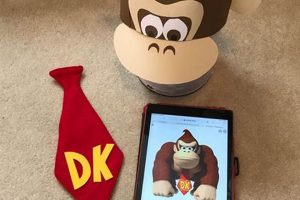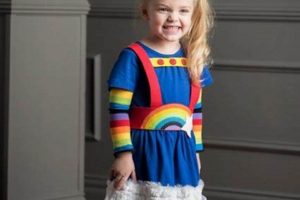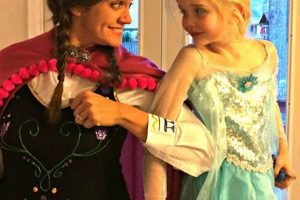Creating a garment resembling the attire of a fictional peacekeeper from a popular science fiction franchise, specifically through do-it-yourself methods, involves assembling or crafting various components. An instance would be constructing a tunic from linen fabric, coupled with self-made leather belts and utilizing pre-existing pants and boots to achieve the desired aesthetic.
Such projects offer numerous advantages, including cost savings compared to purchasing pre-made costumes. These undertakings enable a high degree of personalization, allowing for adjustments to fit, style, and material preferences. Historically, individuals have crafted their own versions of iconic outfits for cosplay events, fan conventions, and themed parties, fostering creativity and resourcefulness.
The following sections will elaborate on specific techniques, material selection, and construction processes useful for replicating the elements involved in achieving this specific appearance.
Crafting a Fictional Peacekeeper’s Garb
The creation of garments replicating the look of a fictional peacekeeper requires attention to detail and careful planning. The following tips offer guidance for a successful outcome.
Tip 1: Fabric Selection: Choose natural fibers like linen or cotton for the tunic and robe. These materials provide breathability and drape well, enhancing authenticity. Consider the weight of the fabric; lighter weights are suitable for warmer climates, while heavier weights offer more structure.
Tip 2: Color Palette Consistency: Maintain a consistent color scheme throughout the ensemble. Earth tones such as beige, brown, and gray are generally appropriate. Avoid stark contrasts that may detract from the overall aesthetic.
Tip 3: Accurate Patterning: Utilize existing patterns as a foundation, modifying them to match the specific design elements of the desired attire. Muslin mock-ups are recommended to refine the fit before cutting into the final fabric. Employ online resources for free sewing patterns.
Tip 4: Belt Construction: Construct belts from sturdy materials such as leather or reinforced vinyl. The belt should be wide and feature a buckle or clasp that is both functional and visually appropriate. Ensure the belt fits snugly around the waist to cinch the tunic.
Tip 5: Boot Selection: Opt for boots that are simple and functional in design. Leather or faux leather boots in brown or black are generally suitable. Avoid boots with excessive detailing or modern styling.
Tip 6: Robe Drape and Length: The outer robe should drape gracefully and reach approximately ankle length. Experiment with different draping techniques to achieve the desired silhouette. Consider adding a hood for added visual appeal. Use heavy fabric to allow robe to hang freely.
Tip 7: Weaponry Considerations: If incorporating a prop lightsaber, prioritize safety and adherence to local regulations. Ensure the prop is lightweight and easily manageable, and store the lightsaber separately from the costume.
By adhering to these guidelines, it is possible to produce a credible and aesthetically pleasing representation of the intended character. The quality of the final product is directly proportional to the effort invested in planning, material selection, and construction.
The subsequent sections will delve into specific resources and techniques useful for refining individual aspects of the garment, ensuring a well-executed and convincing final appearance.
1. Fabric Selection
The choice of fabric is a foundational element in any undertaking aimed at replicating a fictional peacekeeper’s attire, impacting both visual authenticity and wearer comfort. Inadequate fabric selection can undermine the entire project, rendering the resulting garment unconvincing, uncomfortable, or structurally unsound. For example, utilizing synthetic materials with a high sheen will likely detract from the intended aesthetic, presenting a futuristic or anachronistic appearance incongruent with the established visual style.
Conversely, selecting appropriate fabrics like linen, cotton, or wool blends provides the desired texture, drape, and overall visual impression. Linen, with its natural weave and matte finish, is often favored for tunics and robes. The specific weight of the fabric dictates how the garment hangs and moves; lighter-weight linens are suitable for warmer climates or under-layers, while heavier weights offer more structure and warmth for robes intended for cooler environments. The selection should consider the intended use of the garment, whether it is for display, costuming, or active wear.
Therefore, thorough consideration of fabric characteristics, including fiber content, weight, and texture, is crucial for achieving a successful and convincing representation of the intended attire. Neglecting this aspect can result in a finished product that deviates significantly from the desired visual style, diminishing the overall impact. The careful selection of fabrics constitutes a primary step in ensuring a project’s success and enhancing its overall aesthetic value.
2. Pattern Adaptation
Pattern adaptation serves as a pivotal process in replicating a fictional peacekeeper’s garment through do-it-yourself methods. Standard commercial patterns rarely correspond precisely to the desired aesthetic. Therefore, modifications are frequently necessary to achieve an accurate representation.
- Tunic Length and Silhouette Modification
Adjusting the length and overall silhouette of a basic tunic pattern is often required. Examples include elongating the tunic to mid-thigh length or altering the shape to create a more flowing or fitted design. This may involve adding or removing fabric panels or adjusting seam lines to achieve the desired shape. Incorrect length or silhouette will alter the costume’s perceived style.
- Sleeve Style Adjustment
Many standard patterns feature sleeves that do not align with the flowing or kimono-style sleeves often seen in fictional representations. Adapting a sleeve pattern may involve widening the sleeve, adding gussets for greater range of motion, or altering the cuff. Neglecting sleeve style impacts the costume’s authenticity and functionality.
- Robe Pattern Creation from Existing Designs
A formal robe pattern rarely matches the loose robes used in fictional depictions. Adapting a coat or cape pattern to make the garment drape in a flowing, loose style is a required process. Alterations may involve widening the pattern significantly, adding a hood, or modifying the closure style.
- Incorporating Design Elements
Adding design elements, such as pleats, darts, or decorative seams, can enhance the visual appeal and accuracy. These elements may be based on re
ference images or original designs. For example, pleats at the shoulder can create a more structured look, while strategically placed seams can add visual interest.
The successful alteration of existing garment patterns is crucial for achieving the intended look. Neglecting or improperly executing pattern adaptation impacts the costume’s visual veracity, fit, and overall aesthetic appeal. Therefore, a comprehensive understanding of pattern-making principles and careful attention to detail are essential for a successful outcome.
3. Belt Construction
Belt construction is integral to a successful creation mimicking the attire of a fictional peacekeeper, functioning as both a functional and aesthetic element. The belt serves not only to secure the tunic but also as a defining visual component, contributing significantly to the overall impression of the garment. An example is the use of wide leather belts with metallic buckles commonly depicted in visual media, instantly recognizable and synonymous with the attire. A poorly constructed or inappropriately styled belt can detract from an otherwise well-executed costume, while a meticulously crafted belt can elevate the overall presentation. The belt’s prominence necessitates attention to material selection, construction techniques, and accuracy in replicating established designs.
Practical applications of understanding effective belt construction extend beyond mere replication. Individuals engaged in crafting such garments may adapt belt designs to suit personal preferences or functional needs. For instance, adding pouches or holsters to the belt increases its utility for cosplay events or stage performances. The ability to construct a durable and visually appealing belt allows for a greater degree of personalization and customization. Furthermore, understanding the principles of leatherworking or belt-making provides valuable skills that can be applied to other craft projects.
In summary, the connection between belt construction and the successful creation of fictional peacekeeper attire is undeniable. It is a critical component that influences both the functional and aesthetic aspects of the garment. While replication of established designs is important, understanding the underlying principles allows for adaptation and customization. Challenges in belt construction typically involve material sourcing and mastering leatherworking techniques. Proficiency in this area significantly enhances the overall quality and authenticity of the project, contributing to a more convincing and visually compelling representation.
4. Robe Draping
Robe draping represents a critical element in projects replicating the attire of a fictional peacekeeper. The manner in which the robe falls and conforms to the body significantly impacts the overall aesthetic and contributes to a convincing representation. The process involves carefully manipulating fabric to achieve the desired silhouette, volume, and flow, influencing the perceived authenticity of the garment.
- Fabric Weight and Drape Properties
The choice of fabric weight directly correlates to the draping characteristics of the robe. Heavier fabrics, such as wool or thick linen, tend to drape more vertically, creating a straighter silhouette. Lighter fabrics, like silk or thin cotton, exhibit greater fluidity and movement. The fabric’s inherent drape properties determine how the robe conforms to the body and flows with movement, ultimately shaping the overall visual impact. Selecting an inappropriate fabric weight can result in a robe that either lacks structure or appears overly voluminous, detracting from the intended aesthetic.
- Shoulder Construction and Support
The construction of the shoulder area fundamentally influences how the robe hangs. Reinforced shoulders provide structure and prevent the fabric from collapsing, resulting in a more defined silhouette. Conversely, unstructured shoulders allow for a softer, more flowing appearance. The choice depends on the desired aesthetic. Poorly constructed or unsupported shoulders can lead to the robe appearing ill-fitting or unbalanced, compromising the overall visual appeal. Shoulder construction is directly connected to the overall structure of the costume.
- Hood Design and Integration
The hood’s design and how it integrates with the robe significantly affect the draping characteristics around the neck and shoulders. A well-designed hood drapes gracefully, framing the face without obscuring it. Poorly designed hoods can bunch up or pull on the surrounding fabric, disrupting the overall flow of the robe. A hood that sits correctly around the head creates an additional layer of authenticity.
- Seam Placement and Construction Techniques
The strategic placement of seams and the utilization of specific construction techniques can enhance the draping properties of the robe. Angled seams, for instance, can create a more flowing silhouette, while strategically placed darts can shape the fabric to conform to the body’s contours. Improper seam placement can create unwanted bulk or distort the drape, hindering the garment’s overall appearance. Seams can be manipulated to add the desired amount of realism.
These facets underscore the importance of considering robe draping as a critical element in replicating fictional peacekeeper attire. Each aspect interacts to shape the garment’s overall aesthetic. Careful attention to these details contributes to a more authentic, visually appealing, and convincing outcome.
5. Accessory Sourcing
The acquisition of complementary items significantly contributes to the comprehensive realization of a do-it-yourself project replicating the attire of a fictional peacekeeper. Accessories function as crucial visual cues, enhancing the overall authenticity and impact of the ensemble. The selection and integration of these components directly affect the perceived credibility and fidelity of the created costume. For instance, a lightsaber prop, whether commercially produced or self-fabricated, immediately establishes the character’s identity and affiliation. Similarly, utility pouches, belt adornments, and communication devices, though often subtle, provide depth and realism to the representation. Accessory sourcing, therefore, represents a vital step in transforming a basic garment into a convincing and recognizable character portrayal.
Successful accessory sourcing often necessitates a combination of resourcefulness and adaptation. Pre-made items may require modification or repurposing to align with the specific design requirements of the costume. For example, an existing military-style belt pouch could be dyed and fitted with custom closures to resemble a prop seen in visual media. Similarly, off-the-shelf boots can be altered with fabric wraps or gaiters to achieve a more distinctive appearance. Online marketplaces, thrift stores, and surplus retailers serve as potential sources for raw materials and pre-existing components, allowing for cost-effective solutions and personalized approaches. The ability to creatively repurpose and adapt existing items maximizes resource utilization and contribute
s to a unique and individualized final product.
In conclusion, the strategic acquisition and integration of accessories is indispensable to a successful undertaking replicating the attire of a fictional peacekeeper. Careful selection and adaptation contribute significantly to the authenticity and visual impact of the final ensemble. Challenges may include sourcing specific components or mastering fabrication techniques. Proficiency in this area elevates the overall quality and contributes to a more compelling representation. By emphasizing the role of accessories, individuals can transform their creations from simple garments into compelling and immediately recognizable character portrayals.
Frequently Asked Questions
The following section addresses common inquiries pertaining to the creation of garments resembling the attire of fictional peacekeepers, utilizing do-it-yourself methods. Each question is answered with informative and practical guidance.
Question 1: What are the most crucial elements to consider when embarking on such a project?
Material selection, pattern adaptation, and attention to detail represent core considerations. Prioritizing high-quality fabrics, accurately modifying existing patterns, and carefully replicating specific design elements will significantly enhance the final product. Fabric density and the construction of seams play key roles in this endeavour.
Question 2: What fabrics are most appropriate for replicating such garments?
Natural fibers, such as linen, cotton, and wool blends, provide the desired texture, drape, and breathability. Synthetic fabrics generally detract from the overall aesthetic and are therefore discouraged. Fabric that offers the appropriate draping qualities are key to success.
Question 3: How can existing patterns be adapted to match the specific design of fictional garments?
Existing patterns can be modified by adjusting the length, silhouette, and sleeve style. Incorporating design elements, such as pleats, darts, and decorative seams, enhances visual accuracy. Consider modifying or adapting existing sewing patterns.
Question 4: What are the key considerations in constructing a realistic-looking belt?
Belts should be constructed from sturdy materials, such as leather or reinforced vinyl. The buckle or clasp should be both functional and visually appropriate. The belt should fit snugly around the waist to cinch the tunic and provide support.
Question 5: What techniques can be used to achieve the desired drape for an outer robe?
The robes drape is influenced by fabric weight and shoulder construction. Experimenting with different draping techniques and seam placements enhances the silhouette. Heavier materials drape more vertically.
Question 6: How can accessories be sourced or created to complement the overall appearance?
Accessories can be sourced from online marketplaces, thrift stores, and surplus retailers. Existing items can be modified or repurposed to align with the desired aesthetic. Attention to detail in accessory selection significantly enhances the final result. Weapon props should be handled with care.
In summary, successful creation of fictional garments relies on meticulous planning, careful execution, and attention to detail. By addressing these concerns, individuals can achieve a credible and aesthetically pleasing representation.
The subsequent sections will provide additional resources and insights for further refinement of the garments. Consider this information for the best costume build.
jedi knight costume diy
This discourse has examined the complexities inherent in replicating the attire associated with fictional peacekeepers, employing do-it-yourself methodologies. Key considerations encompassing material selection, pattern adaptation, accessory sourcing, and construction techniques have been delineated. These factors directly influence the aesthetic accuracy and overall quality of the resulting garment.
A thorough understanding of these principles enables individuals to approach such projects with informed precision. Continued exploration and refinement of these skills fosters greater appreciation for the craftsmanship involved. Diligence in this pursuit yields results that are both visually compelling and personally rewarding.







